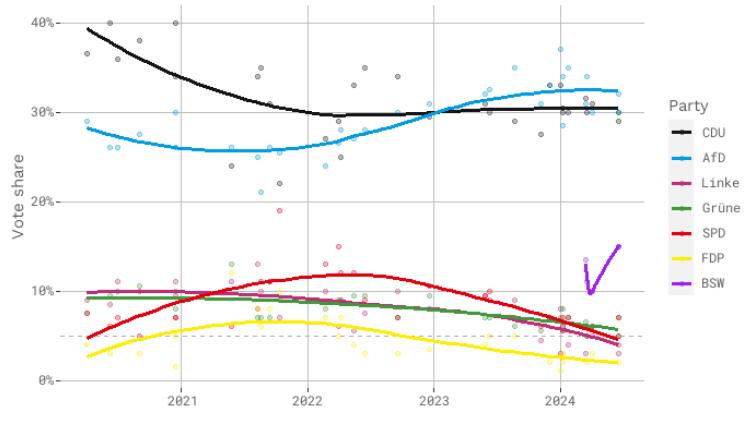2024 German State elections
Sign up here to receive our regular Election Note! Read the full analysis and receive the full version of each note as soon as it is published.
Published 12 August 2024
Key findings
Upcoming state elections in Brandenburg, Saxony and Thuringia will set the tone for the country’s 2025 federal election campaign. As a barometer of broader political trends, the results are likely to mark out the ruling coalition as on the backfoot.
The contested regions are proving to be a difficult battleground for the German centre. The far-right AfD leads the polls in all three states, while the left-wing BSW is also projected to attract a sizeable share of the vote.
These factors are likely to make coalition formation extremely complicated. Our analysis illustrates that there are few, if any, possible majority coalitions under current polling.
1. What is at stake?
With German Federal Elections planned for 2025, the country is gearing up for a busy election year. In September, voters in three of Germany’s eastern regions will kick off with three highly contested State elections (Landtagswahlen) in Brandenburg, Saxony and Thuringia. This note provides a brief overview of the current shape of these three State elections and their potential consequences.
Why do these elections matter? German State elections are important for several reasons. First of all, the results of these elections determine the composition of state parliaments and governments, which in turn influence regional policy-making on issues like education, policing, economic development, and more. More indirectly, the results of the State elections can affect the composition of the Bundesrat, the upper house of the German parliament, which reflects the states. The Bundesrat can be an important veto-player in federal German policy-making, and therefore, the results of the state elections also affect national policy outcomes.
However, beyond their influence on policy outcomes, there is another respect in which these elections arguably matter even more. German state elections are often read as a barometer for broader political trends and the health of the country’s major political parties. Strong regional performance can rejuvenate a party’s national election campaign, while a slump could cast a shadow over the party’s federal efforts as well. In the three September elections, the risk of a slump for the German governing coalition is significant. All three parties are set to lose seats, while the far-right AfD is predicted to gain. Meanwhile, the BSW – a new party established in January 2024, whose appeal combines left-wing economic politics with social conservative positions on cultural issues – has emerged onto the regional scene as a powerful political force. Recent polling has shown that party drawing support from both the left and the right (see Figure 1).
Figure 1: Predicted polling swing compared to previous State elections
That leaves two major questions. First, what practical implications will the elections have for government formation in the regions? The expected surge in AfD support, between +2% and +5% compared to 2019 according to the polls, will make the formation of a centrist coalition difficult in all three of the regions. In turn, this leaves mainstream parties, and especially the CDU, with tough questions. Are they willing to depart from a broad coalition in the centre to one which includes the flanks? This will definitely not be easy: the CDU has already ruled out coalitions with the far-left, and a coalition with the far-right AfD would profoundly alienate moderate voters.
Second, what signal will the election results send about the broader state of German politics? Further losses for the SPD will be a significant blow to Chancellor Scholz, risking further infighting in his coalition and significant complications for policy making. However, analysts will also be closely watching the CDU’s response to a potential election victory. Will they be able to offer a serious alternative coalition to another SPD government? The regional level has often functioned as a testing ground for coalitions before they are trialled at the federal level. It may well do so again.
2. What is the state of play?
So how are things currently looking? The three races - in Brandenburg, Saxony, and Thuringia - each have quite different local dynamics but they also have one thing in common: the AfD is leading the polls. This is not a surprise. The AfD currently enjoys relatively high federal popularity at 17% of the vote in current polls, and has also traditionally seen higher support in these East German states. However, a further complicating factor in these East German races is the strong performance that is expected from the BSW. Together, a strong AfD and BSW create a difficult situation for what is left of the German moderate parties.
The race is tightest in Saxony (see Figure 2). Currently, the AfD leads by a single percentage point in the polls, with the centre-right CDU – led by the incumbent Minister-President of Saxony, Michael Kretschmer – on their heels. The BSW is in third with approximately 15% of the vote, drawing voters from Die Linke especially. As a result, the latter party is currently at risk of falling below the 5% threshold, which would see them lose all parliamentary representation in the region. This would be a bitter pill to swallow for Die Linke, after finishing third with 10.4% of the vote at the last Saxonian regional election. It is also worth noting that the incumbent federal coalition - the SPD, the Greens, and FDP - are currently polling on a combined vote share of 14% in the region. This is significantly lower than their combined result at the previous regional election, where they won a combined 20.8% of the vote.
Figure 2: Saxony polling trends by party
In Brandenburg, the AfD leads with a slightly larger margin, while the race for second place is still wide open (see Figure 3). With the AfD hovering around 24%, the chasing pack consists of the SPD, the CDU and the BSW, all polling between 17% and 19% of the vote. Like in Saxony, the rise of the BSW has come at the expense of both the AfD and Die Linke. Again, the latter party is at risk of falling below the electoral threshold and losing parliamentary representation. It won 10.7% at the 2019 elections, but achieved just 4.4% of the Brandenburg vote in the recent European elections.
Figure 3: Brandenburg polling trends by party
Lastly, Thuringia is the state where the problem for the German political centre is most acute. Not only does the AfD hold a sizable lead (see Figure 4), but the BSW is also expected to do well. Thuringia was the state where the BSW achieved one of its strongest results in the European Parliament elections in June. With the AfD on 29% and the BSW on 21%, these two parties alone are currently set to win 50% of the vote, according to polls. Here too, the rise of the BSW has squeezed Die Linke, which was the largest party in the 2019 Thuringian elections but now polls at around 13% of the vote. The Greens and the FDP, meanwhile, are at risk of falling below the 5% threshold, having only just exceeded it in 2019.
Figure 4: Thuringia polling trends by party
3. What does this mean for coalition-making in the regions?
The further fragmentation of German party politics will almost certainly complicate the regional government formation process significantly. Whilst the rise of powerful new parties – in this case the BSW – always creates challenges for coalition making, in the September elections this issue will be exacerbated by the fact that moderate parties have ruled out governing with the flanks. All moderate parties have explicitly stated that they will not govern with the AfD, while the CDU leader, Friedrich Merz, has ruled out forming a coalition with BSW in the regions.
This does not leave many possible coalitions, as Figure 5 illustrates. Here, we have excluded all coalition options that a) fall far short of the 50% majority threshold, b) include parties that have ruled out governing together, and c) include parties that are currently projected to miss the 5% threshold. This leaves four types of coalitions:
Grand coalition: This is a traditional coalition of Germany's two largest parties, the SPD and the CDU. It is often formed when other combinations fail to produce a stable majority. Although it brings together quite different ideologies, it tends to focus on pragmatic governance.
Kenya coalition: Named after the colours of the Kenyan flag (red for SPD, black for CDU, and green for the Greens), this is a broad coalition that includes both centre-left and centre-right parties. Like the grand coalition, this also tends to be a pragmatic solution when no other majority is possible.
Left coalition with SPD, the Greens, and BSW: Given the BSW’s economically left-wing but nationalist and socially conservative stances, this would be a complex coalition for which governance would likely be fraught. The SPD and Greens would need to find a way to work with the BSW, and the latter’s scepticism of green policies and the European Union could prove particularly problematic.
Left coalition with SPD, Die Linke, and BSW: Although this coalition brings together parties with shared roots in left-wing politics, the three have expressed substantially different policy positions. Die Linke and BSW also have overlapping voter bases, particularly in economically disadvantaged areas. Electoral rivalry, as well as BSW’s more nationalist and Eurosceptic stances, could therefore cause tension.
Figure 5: Estimated vote shares of current coalition options per region given current polling
Figure 5 illustrates just how difficult government formation is likely to be. In Brandenburg, the Kenya coalition is currently the only coalition reaching an absolute majority in terms of votes, closely followed by a more experimental SPD-Green-BSW coalition. Given that the former is more of a known quantity, we consider that option to be the most likely outcome under current polling.
In both Saxony and Thuringia, the situation is considerably more complicated. In Saxony, the Kenya coalition is the only group coming close to a majority. The precise seat results will make clearer whether this is a feasible majority coalition. If not, another alternative could be a coalition of the flanks between AfD and BSW. This would represent a significant shift in German regional politics, though it is currently unclear whether the parties would agree to it. In Thuringia, moderate coalitions also appear to fall far short of a majority, especially if the Greens do not make the electoral threshold. A novel coalition of SPD, Die Linke and BSW is the only major party coalition coming close to 50%, but polling at a combined 44%, even this does not currently reach that threshold. Here too, a more extreme coalition between AfD and BSW could break the deadlock. Combined, these two parties currently poll at 54%.
Ultimately, the precise election results will decide what majority coalitions are possible. However, it is clear that these regional elections could mark a significant break in German politics. German regional coalitions have traditionally been moderate and pragmatic. However, both in Saxony and Thuringia, and to a lesser extent in Brandenburg, these moderate coalitions struggle to reach a majority. Should these coalitions prove impossible, this might even open the door for AfD influence in East Germany’s regions.
We are also keeping an eye on:
US elections - With the battleground states and districts rapidly shaping up, where do the paths to victory for both parties lie? We’re providing private weekly forecasts (Presidential, Senate and House) through November 5th: contact us to buy in.





